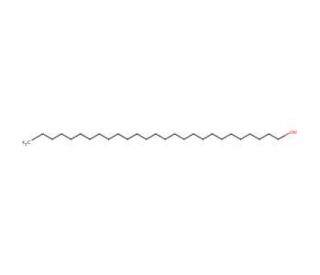

1-Heptacosanol (CAS 2004-39-9)
QUICK LINKS
1-Heptacosanol is a long-chain aliphatic alcohol that has been extensively studied for its role in plant biology, lipid metabolism, and material science. This 27-carbon primary alcohol is a key component of plant cuticular waxes, where it contributes to the formation of protective barriers on leaf and fruit surfaces. In research, 1-heptacosanol is utilized to investigate the biosynthesis and function of cuticular waxes, providing insights into plant physiology and defense mechanisms. Additionally, it serves as a model compound for studying the physical properties of long-chain alcohols, such as melting points, crystallinity, and phase transitions, which are important for understanding the structural characteristics of natural waxes and synthetic analogs. In biochemical studies, 1-heptacosanol is employed to explore its metabolism and enzymatic transformation within biological systems. Researchers use it to study the activity of alcohol dehydrogenases and other enzymes involved in lipid metabolism, shedding light on the pathways and regulatory mechanisms of long-chain alcohol metabolism. Furthermore, 1-heptacosanol has applications in the development of novel materials, including lubricants, coatings, and biodegradable polymers, where its hydrophobic properties and chemical stability are advantageous. Overall, 1-heptacosanol′s significance in plant biology, biochemistry, and materials science underscores its importance in advancing our understanding of lipid-related processes and developing innovative applications in various research fields.
1-Heptacosanol (CAS 2004-39-9) References
- Inhibitory potential of Turbinaria ornata against key metabolic enzymes linked to diabetes. | Unnikrishnan, PS., et al. 2014. Biomed Res Int. 2014: 783895. PMID: 25050371
- Gas Chromatography Mass Spectrometry Profiling in Methanolic and Ethyl-acetate Root and Stem Extract of Corbichonia decumbens (Forssk.) Exell from Thar Desert of Rajasthan, India. | Arora, S. and Saini, M. 2017. Pharmacognosy Res. 9: S48-S52. PMID: 29333042
- Comparison of the Proximate Composition, Vitamins (Ascorbic Acid, α-Tocopherol and Retinol), Anti-Nutrients (Phytate and Oxalate) and the GC-MS Analysis of the Essential Oil of the Root and Leaf of Rumex crispus L. | Idris, OA., et al. 2019. Plants (Basel). 8: PMID: 30823426
- Therapeutic Efficacy of Nyctanthes arbor-tristis Flowers to Inhibit Proliferation of Acute and Chronic Primary Human Leukemia Cells, with Adipocyte Differentiation and in Silico Analysis of Interactions between Survivin Protein and Selected Secondary Metabolites. | Heendeniya, SN., et al. 2020. Biomolecules. 10: PMID: 31973079
- Antioxidant and Anti-inflammatory Metabolites of a Soil-Derived Fungus Aspergillus arcoverdensis SSSIHL-01. | Skanda, S. and Vijayakumar, BS. 2021. Curr Microbiol. 78: 1317-1323. PMID: 33638673
- Physicochemical Characterization and Antimicrobial Activity against Erwinia amylovora, Erwinia vitivora, and Diplodia seriata of a Light Purple Hibiscus syriacus L. Cultivar. | Sánchez-Hernández, E., et al. 2021. Plants (Basel). 10: PMID: 34579407
- Immunomodulatory efficacy of Cousinia thomsonii C.B. Clarke in ameliorating inflammatory cascade expressions. | Dar, KB., et al. 2023. J Ethnopharmacol. 300: 115727. PMID: 36116611
- Antifungal Activity of Bioactive Compounds Produced by the Endophytic Fungus Paecilomyces sp. (JN227071.1) against Rhizoctonia solani. | Hawar, SN., et al. 2023. Int J Biomater. 2023: 2411555. PMID: 37122583
- Anti-diabetic and anti-urease inhibition potential of Amomum dealbatum Roxb. seeds through a bioassay-guided approach. | Sonia, H., et al. 2024. Nat Prod Res. 1-6. PMID: 38189677
- Launaea fragilis extract attenuated arthritis in rats through modulation of IL-1β, TNF-α, IL-6, NF-κB, COX-2, IL-4, and IL-10. | Fiaz, M., et al. 2024. Inflammopharmacology.. PMID: 38714603
- GC/MS chemical profiling and isolation of secondary metabolites from Leontice ewersmannii. | Omirzakova, N., et al. 2024. Nat Prod Res. 1-5. PMID: 38747236
Ordering Information
| Product Name | Catalog # | UNIT | Price | Qty | FAVORITES | |
1-Heptacosanol, 100 mg | sc-208641 | 100 mg | $204.00 | |||
1-Heptacosanol, 250 mg | sc-208641A | 250 mg | $490.00 |
